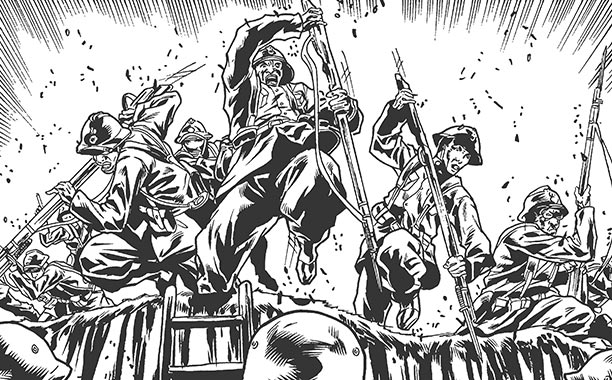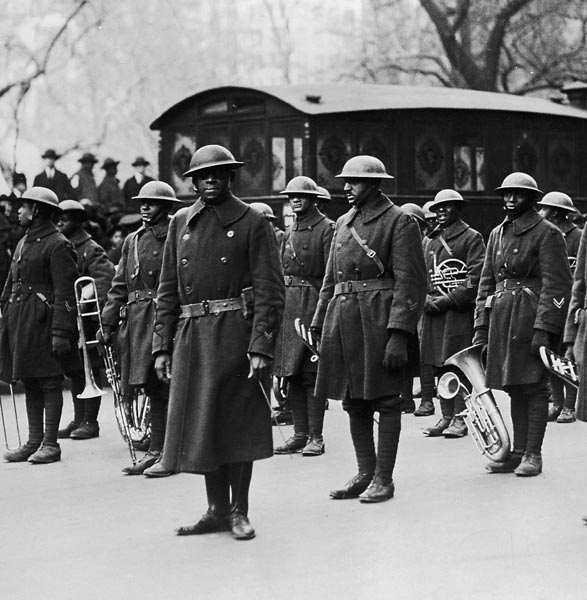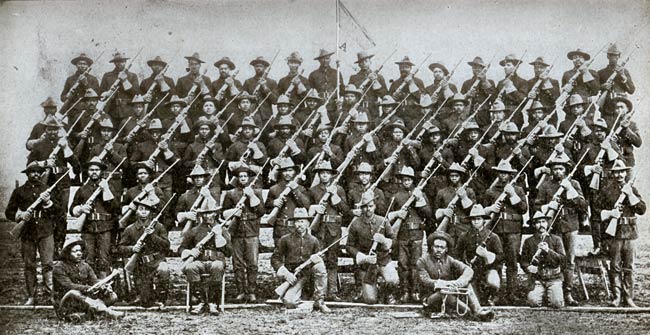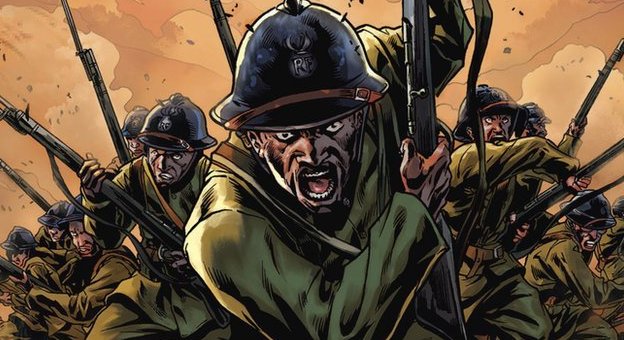The Harlem Hellfighters was the most decorated regiment of the US military in World War One. It was an all-Black military regiment and the 369th Infantry Regiment of the US Army that proved crucial in the War.
The German nickname ‘Hell Fighters’ was given to them because the Germans could not fathom their toughness, valor, bravey and skill, in addition to the fact that they never lost a man through capture, lost a trench or a foot of ground to the Germans.
At one point they lost some three men through capture but in less than 7 hours they had recovered their men and decimated the German regiment.
Legendary Reggae musician, Bob Marley (R.I.P) of Jamaica, had nicknamed them the Baffalo Soldiers in his famous song.
Formerly known as the 15th New York National Guard Regiment, was an infantry regiment of the United States Army that saw action in both World War I and World War II.
The Regiment consisted of African-Americans and African Puerto Ricans and was known for being the first all-African-American regiment to fight alongside the American Expeditionary Force during World War I.
And why would an all-Black infantry brigade help racist America in Wold War One or Two?
They had trained in South Carolina, where they were taunted and subjected to beating by fellow white military personnel and even some ordinary South Carolinians. But they were ordered by the US government not to fight back.
At that juncture they knew the repercussions of any act of aggression against white people in America would be tantamount to execution by hanging by the same government.
So 369th infantry regiment waited for their chance in Europe perhaps to gauge their prowess as military men against white men – the Germans – or perhaps to show that white men, like all humans, died like ordinary men, and diffuse the myth about white courage and bravery.
This was intrinsic for their own edification and self-determination, their forefathers having been forced from their great past in West Africa and subjected to the inhumanity of slavery in America, amidst the propaganda that white men were god-chosen, stronger and braver.
So they didn’t fight back in America, exercising extreme discipline for a regiment that had trained to fight and to kill. Max Brooks has made an attempt to tell their tale in a new graphic novel. In his story, their self restraint was nothing short of heroic.

A priori, the US government was reluctant to admit African Americans into the military to fight alongside their fellow white soldiers, but Western Europe faced an existential problem.
In America, the white US government was faced with a dilemma. How would white America’s propaganda that white men were stronger and could not be killed by black men be justified if the US were to use the 369th Infantry Brigade to kill fellow whites – the blonde blue eyed Germans – in Europe?
At the same time, while this debate ensued in the US, the immense contribution by African Kingdoms who had enlisted some of their brave Asafo (military) men and women to help France and Britain win the war against the Germans could not be overlooked by the senate and congress of the US government.
It was in this light that the bravery of African American soldiers as a crucial part of the US military force in World War One had to be considered. If the US military was to show equal valor alongside Africans soldiers, the French and the British, the all-Black 369th Infantry Brigade had to be deployed in Europe.
Even after the war in 1919, when the regiment had returned to New York as decorated heroes alongside their African, French and British fellows, they were plunged into some of the worst racial violence the US had ever seen.
The regiment was nicknamed the ‘Harlem Hellfighters’ by the Germans, the ‘Black Rattlers’ by the British and the ‘Men of Bronze’, which was given to the regiment by the French.
The ‘Harlem Hellfighters’ were probably the first all-Black regiment (much African American military history has been hidden from the public by the US government) that begun to dent white American propaganda on African American soldiers and African Americans in general, and helped pave the way for dialogue.
Before this 15th New York National Guard Regiment was formed, any African American that wanted to fight in the war either had to enlist in the French or Canadian armies.
The regiment went into combat in the Second Battle of the Marne. Later the 369th was assigned to the 161st Division to participate in the Allied counterattack. On one tour they were out for over 6 months which was the longest deployment of any unit in World War I. On 19 August, the regiment went off line for rest, training and replacements.
Even while overseas the Hellfighters saw propaganda against them. Mostly from Germans. Apparently the Germans were so terrified that they tried to persuade the African American soldiers to switch camp.
Many of the German propaganda prescribed why Africans or African Americans would fight them. That the Germans had done nothing wrong to black folk so why would they fight against them? They implored the black soldiers to switch camp and fight against their racist government in America especially.
On 25 September 1918 the French 4th Army went on the offensive in conjunction with the American drive in the Meuse-Argonne. The 369th turned in the most outstanding account in heavy fighting, sustaining severe losses.

They captured the important village of Séchault. At almost every point the 369th advanced faster than the French troops on their right and left flanks, and even risked getting cut off. By the time the regiment pulled back for reorganization, it had advanced fourteen kilometers through severe German resistance.
In mid-October the regiment was moved to a quiet sector in the Vosges Mountains. It was there on 11 November, the day of the Armistice. Six days later, the 369th made its last advance and on 26 November, reached the banks of the Rhine River, the first Allied unit to reach it.
The regiment was relieved on 12 December 1918 from assignment to the French 161st Division. It returned to the New York Port of Embarkation and was demobilized on 28 February 1919 at Camp Upton at Yaphank, New York, and returned to the New York Army National Guard.
Black achievements and valor went unnoticed in the racist West, despite the fact that over 100 men from the 369th were presented with American and/or French medals.
Among those honors was Pvt. Henry Lincoln Johnson, a former Albany, New York, rail station porter, who earned the nickname “Black Death” for his actions in combat in France.
In May 1918 Johnson and Pvt. Needham Roberts fought off a 24-man German patrol, though both were severely wounded. After they expended their ammunition, Roberts used his rifle as a club and Johnson battled with a bolo knife. Reports suggest that Johnson killed at least 12 German soldiers and might have wounded 30 others.
Johnson was the first American to receive the Croix de Guerre awarded by the French government. This award signifies extraordinary valor. By the end of the war, 171 members of the 369th were awarded the Legion of Honor or the Croix De Guerre as well.
Despite the fact that they were decorated upon returning to New York, the 369th Regiment were not allowed to participate in Victory Parade of 1919. They were also disrespected and were not given a salute by senators and congress men who were under orders by the US government not to.












Love Bob Marley and Buffalo Soldiers! Glad to hear the origin of the song’s titles. There’s always tons of substance to Marley’s songs.